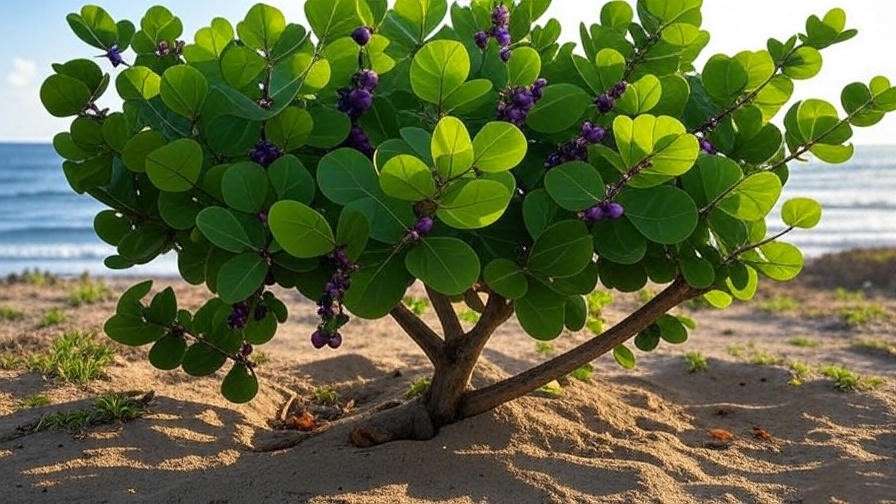Picture a coastal garden where lush, broad leaves sway gently in the ocean breeze, vibrant purple grapes dangle invitingly, and a sturdy sea grape tree stands as the centerpiece of your landscape. The sea grape tree (Coccoloba uvifera), a coastal gem, is more than just a plant—it’s a statement of resilience and natural beauty. Whether you’re a homeowner near the shore or a gardening enthusiast, mastering sea grape tree care can transform your outdoor space into a tropical haven. In this comprehensive guide, we’ll walk you through every step to grow and maintain a thriving sea grape tree, from planting to harvesting its unique fruit. With expert insights drawn from years of horticultural experience and coastal ecology studies, this article is your roadmap to success. 🌿
What Is a Sea Grape Tree? 🌿
Botanical Overview
The sea grape tree, scientifically known as Coccoloba uvifera, is a native of coastal regions, thriving in areas like the Caribbean, Florida, and parts of Central and South America. Its hallmark features include large, round, leathery leaves that turn vibrant shades of red and bronze as they age, and clusters of grape-like fruit that ripen to a deep purple. This evergreen shrub or tree can grow up to 25–50 feet tall, though it’s often maintained as a shorter hedge or ornamental plant. Its salt-tolerant nature makes it a favorite for seaside landscapes.
Ecological and Aesthetic Benefits
Sea grape trees are ecological powerhouses. Their deep root systems help stabilize sandy soils, making them invaluable for preventing coastal erosion. The dense foliage provides shade and habitat for birds and pollinators, enhancing local biodiversity. Aesthetically, the sea grape’s broad leaves and colorful fruit add a tropical flair to any garden, making it a popular choice for both private yards and public spaces like beachfront parks. 🌊
Why Choose a Sea Grape Tree?
Why opt for a sea grape? Its low-maintenance care, resilience to salty air, and versatility as a tree, shrub, or hedge make it ideal for coastal gardeners. Plus, the edible fruit offers culinary possibilities, from homemade jellies to fresh snacks. Whether you’re aiming to enhance your garden’s beauty or contribute to coastal ecosystems, the sea grape tree is a rewarding choice.
Planting Your Sea Grape Tree: Getting Started Right 🌱
Choosing the Perfect Location
To ensure your sea grape tree thrives, location is key. These plants love full sun but can tolerate partial shade, making them adaptable to various coastal settings. Choose a spot with sandy, well-draining soil, as sea grapes dislike waterlogged roots. Their salt tolerance means they can grow close to the ocean, but avoid areas with constant saltwater spray to prevent leaf burn. Aim for a location at least 10–15 feet from other large plants to allow for their spreading growth.
When and How to Plant
The best time to plant a sea grape tree is in spring or early summer when temperatures are warm, promoting root establishment. Here’s a step-by-step guide:
- Dig the Hole: Create a hole twice as wide and as deep as the root ball.
- Prepare the Soil: Mix native soil with organic compost for nutrient-rich planting.
- Place the Tree: Set the sapling in the hole, ensuring the root collar is level with the ground.
- Backfill and Water: Fill the hole, tamp down gently, and water thoroughly.
For container planting, use a large pot with drainage holes and a sandy soil mix. Space multiple sea grapes 6–10 feet apart if creating a hedge.
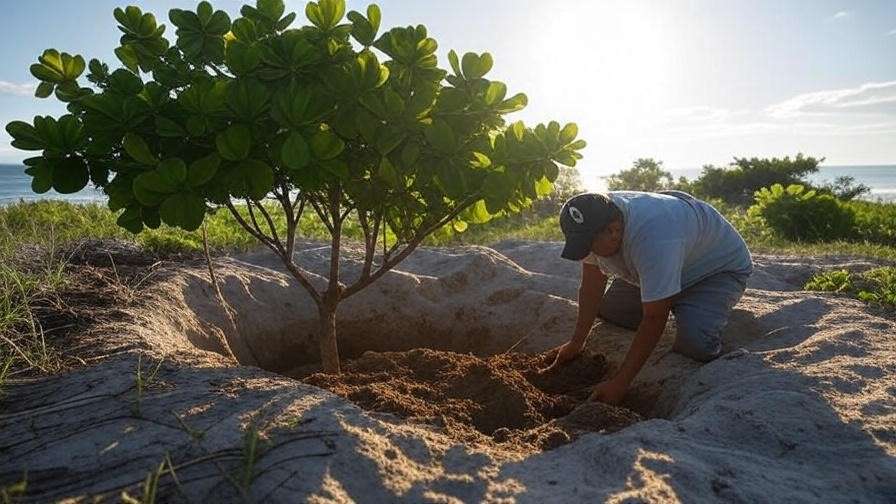
Selecting Healthy Sea Grape Saplings
When purchasing a sea grape, inspect for vibrant green leaves, a sturdy stem, and no signs of pests or disease. Avoid plants with yellowing leaves or root-bound containers. Reputable nurseries or garden centers specializing in coastal plants are your best bet. Checklist: Ensure the sapling has at least 3–4 healthy branches, a moist root ball, and no visible damage.
Expert Tip: Test soil drainage before planting by filling a hole with water—if it drains within 2–3 hours, you’re good to go!
Essential Care Tips for a Thriving Sea Grape Tree 🌞
Watering Requirements
Young sea grape trees need regular watering to establish roots. Water deeply twice a week for the first 6 months, ensuring the soil stays moist but not soggy. Once established, sea grapes are drought-tolerant and can rely on natural rainfall in coastal climates. Watch for signs of overwatering, like yellowing leaves or mushy roots, and adjust based on local rainfall patterns. In dry spells, provide supplemental watering every 10–14 days.
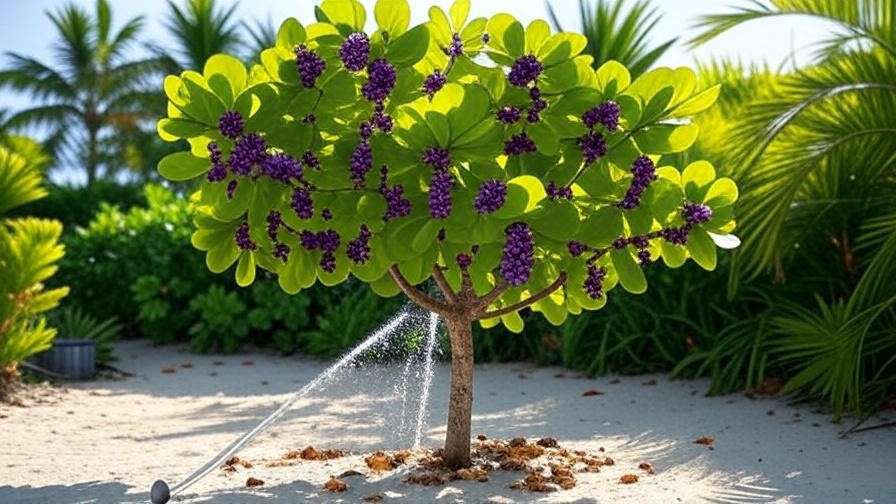
Fertilizing for Optimal Growth
Sea grapes don’t require heavy feeding, but a balanced, slow-release fertilizer (e.g., 10-10-10) applied in spring can boost growth. Avoid high-nitrogen fertilizers, as they promote leafy growth at the expense of fruit. Organic options like compost or seaweed-based fertilizers are excellent for eco-conscious gardeners. Apply fertilizer around the drip line, not directly at the base, and water thoroughly afterward. Fertilize no more than twice a year to prevent nutrient burn.
Pruning and Shaping
Pruning keeps your sea grape tree healthy and aesthetically pleasing. Prune in late winter or early spring before new growth begins. Remove dead, damaged, or crossing branches to improve airflow and light penetration. For a hedge, trim to maintain a uniform shape, keeping the top narrower than the base. If growing as a tree, remove lower branches to encourage a single trunk. Always use clean, sharp pruning shears to avoid disease transmission.
Sunlight and Temperature Needs
Sea grapes thrive in temperatures between 60–85°F (15–29°C), making them perfect for warm coastal climates. They can tolerate brief dips to 40°F but may suffer in prolonged cold. If a rare cold snap is forecast, cover young trees with frost cloth. Ensure they receive at least 6 hours of sunlight daily for optimal growth and fruit production.
Expert Insight: Coastal horticulturist Dr. Jane Ellis notes, “Balancing pruning with natural growth allows sea grapes to maintain their iconic shape while promoting long-term health.”
Protecting Your Sea Grape Tree from Pests and Diseases 🐞
Common Pests
While sea grapes are resilient, they can attract pests like scale insects, aphids, and caterpillars. Scale appears as small, waxy bumps on stems, while aphids cluster on new growth. Caterpillars may chew leaves, leaving visible holes. Control pests with neem oil or insecticidal soap for organic solutions, or consult a professional for chemical treatments. Companion planting with marigolds or garlic can deter pests naturally.
Disease Prevention
In humid coastal climates, fungal diseases like leaf spot can occur. Ensure good airflow through regular pruning and avoid overhead watering. Root rot, caused by poor drainage, is another concern—always plant in well-draining soil. Monitor leaves for dark spots or wilting, and treat early with fungicides if needed. Healthy sea grapes are naturally resistant, so proactive care is key.
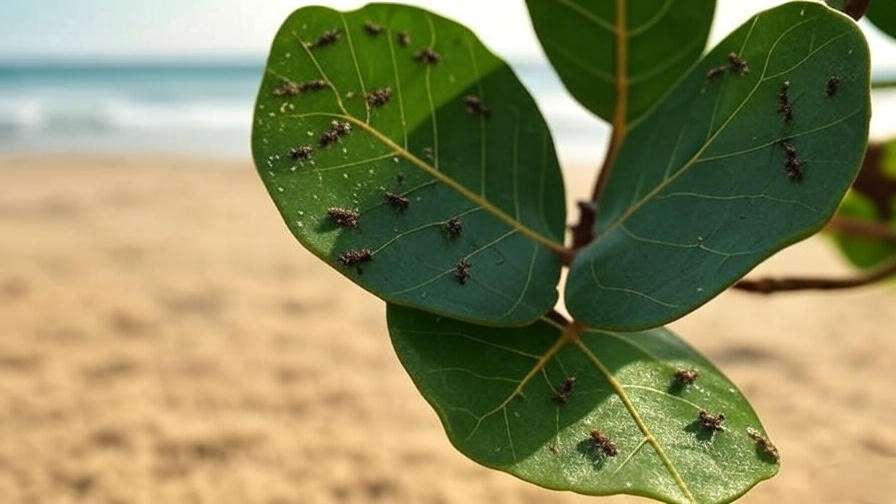
Salt and Wind Tolerance
Sea grapes excel in salty, windy environments, but extreme conditions can stress them. Stake young trees to protect against strong coastal winds, and rinse leaves occasionally to remove salt buildup. Their thick leaves naturally shield them from moderate salt spray, making them a top choice for beachfront properties.
Pro Tip: Use the table below for quick pest identification and treatment:
| Pest | Symptoms | Treatment |
| Scale Insects | Waxy bumps on stems | Neem oil, manual removal |
| Aphids | Sticky residue, curled leaves | Insecticidal soap, ladybugs |
| Caterpillars | Chewed leaves, visible larvae | Hand-picking, Bt spray |
Harvesting and Using Sea Grape Fruit 🍇
When and How to Harvest
Sea grape fruit ripens in late summer to fall, turning from green to deep purple. Harvest when grapes are plump and slightly soft to the touch. Gently twist or cut clusters from the tree to avoid damaging branches. Wear gloves to protect your hands from the fruit’s mild astringency. Harvest in the morning for the best flavor and to reduce stress on the plant.
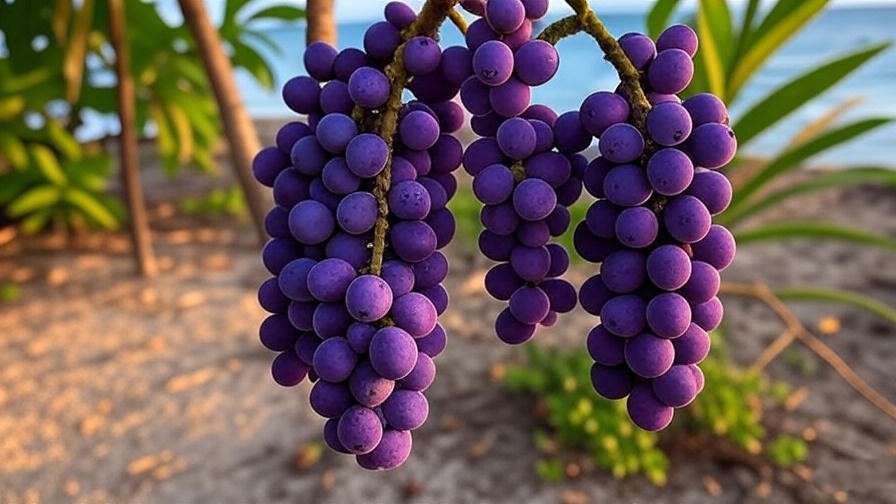
Culinary and Practical Uses
Sea grape fruit is tart and slightly sweet, perfect for culinary creativity. Popular uses include:
- Sea Grape Jelly: Boil fruit with sugar and pectin for a vibrant, tangy spread.
- Smoothies: Blend ripe grapes with tropical fruits like mango or pineapple.
- Fresh Eating: Enjoy as a snack, though consume in moderation due to astringency.
In Caribbean cultures, sea grapes are a traditional ingredient in jams and wines. Always avoid unripe (green) fruit, as it can cause stomach upset.
Storing and Preserving
Store fresh sea grapes in a breathable container in the refrigerator for up to a week. For long-term preservation, freeze whole grapes or dry them into a chewy snack. To make jelly, process fruit within 1–2 days of harvesting for optimal flavor. Label and date preserved goods to track freshness.
Fun Fact: In the Bahamas, sea grape jelly is a cultural staple, often served at festivals and family gatherings.
Troubleshooting Common Sea Grape Tree Problems ⚠️
Yellowing or Dropping Leaves
Yellowing or dropping leaves can signal stress in your sea grape tree. Common causes include:
- Overwatering: Check soil moisture—soggy soil indicates poor drainage. Reduce watering and ensure the planting site drains well.
- Nutrient Deficiency: Lack of potassium or magnesium can cause yellowing. Test soil and apply a balanced fertilizer if needed.
- Salt Burn: Excessive salt spray may scorch leaves. Rinse foliage with fresh water and consider a windbreak for exposed plants.
Solution: Adjust watering to once every 10–14 days for established trees, test soil pH (ideal range: 6.0–7.5), and apply a foliar spray of micronutrients for quick recovery.
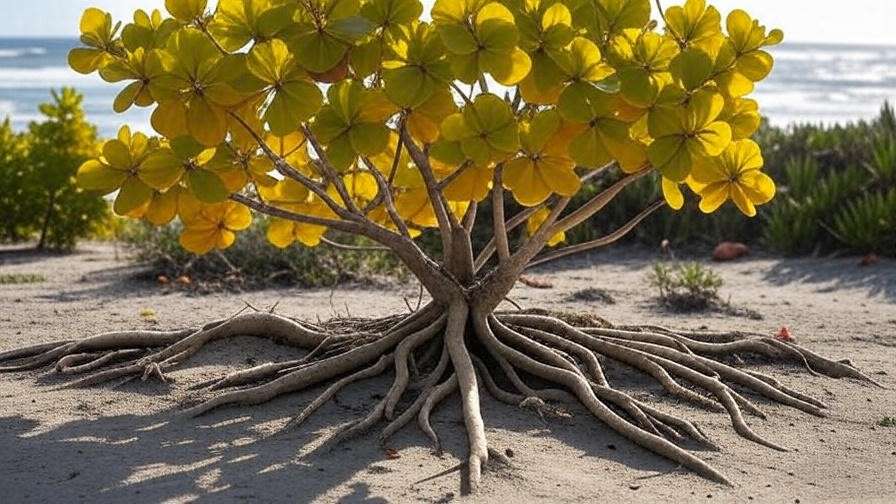
Stunted Growth
If your sea grape tree isn’t growing as expected, consider these factors:
- Poor Soil Quality: Sandy soils low in organic matter may limit growth. Amend with compost or organic mulch.
- Insufficient Light: Less than 6 hours of daily sunlight can slow development. Relocate container plants or trim nearby shade sources.
- Root Issues: Root-bound plants or compacted soil restrict growth. For potted trees, repot into a larger container every 2–3 years.
Solution: Conduct a soil test through a local extension service, ensure adequate sunlight, and gently loosen roots during repotting.
Fruit Production Issues
Low fruit yield can frustrate gardeners. Potential reasons include:
- Pollination Challenges: Sea grapes are dioecious, meaning male and female flowers grow on separate trees. Ensure both genders are present for fruiting.
- Environmental Stress: Drought or nutrient imbalance can reduce fruiting. Maintain consistent care routines.
- Young Age: Trees under 3–5 years old may not yet produce fruit reliably.
Solution: Plant multiple sea grapes to ensure cross-pollination, maintain a fertilization schedule, and be patient with young trees.
Expert Advice: Use the flowchart below for quick troubleshooting:
[Yellowing Leaves] –> [Check Soil Moisture] –> [Soggy?] –> [Reduce Watering, Improve Drainage]
–> [Dry?] –> [Test Soil Nutrients] –> [Apply Balanced Fertilizer]
[Stunted Growth] –> [Evaluate Sunlight] –> [<6 Hours?] –> [Relocate or Trim Shade]
–> [Check Soil] –> [Amend with Compost]
[Low Fruit Yield] –> [Check Tree Gender] –> [Only Male?] –> [Plant Female Tree]
–> [Environmental Stress?] –> [Ensure Consistent Care]
Advanced Tips for Sea Grape Tree Enthusiasts 🌟
Propagating Sea Grape Trees
Propagating sea grapes allows you to expand your garden or share plants with others. Two methods work well:
- Seed Propagation:
- Collect ripe, purple fruit and remove the pulp to access seeds.
- Soak seeds in water for 24 hours to soften the outer coating.
- Plant in a sandy soil mix, covering lightly, and keep moist in a sunny spot.
- Expect germination in 4–8 weeks.
- Cuttings:
- Take 6–8-inch semi-hardwood cuttings in spring.
- Dip the cut end in rooting hormone and plant in a sandy, well-draining mix.
- Keep in a humid, shaded area until roots develop (6–10 weeks).
Pro Tip: Cuttings often root faster than seeds and preserve the parent plant’s traits.
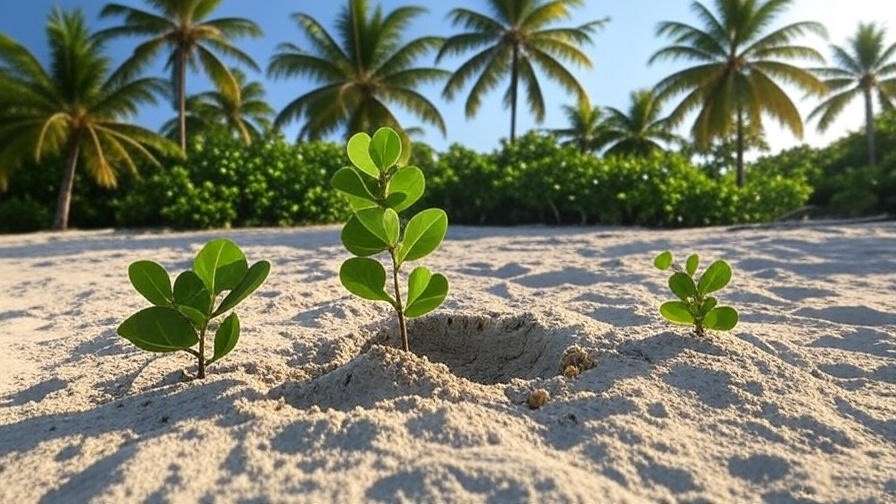
Landscaping with Sea Grapes
Sea grape trees are versatile in landscape design:
- Hedges: Plant 4–6 feet apart for a dense, privacy-screening hedge.
- Focal Points: Train a single sea grape into a multi-trunk tree for a striking centerpiece.
- Privacy Screens: Combine with other natives like saw palmetto for a natural barrier.
Companion Plants: Pair with salt-tolerant species like beach sunflower (Helianthus debilis) or blanket flower (Gaillardia pulchella) for a vibrant coastal garden.
Eco-Friendly Practices
Sustainability enhances your sea grape’s impact:
- Mulching: Apply 2–3 inches of organic mulch (e.g., bark or coconut husk) to retain moisture and suppress weeds.
- Rainwater Harvesting: Use collected rainwater for irrigation to reduce freshwater use.
- Native Planting: Incorporate sea grapes into native plant gardens to support local ecosystems.
Case Study: In a Florida dune restoration project, sea grapes were planted alongside sea oats, reducing erosion by 30% and boosting wildlife presence.
FAQs About Sea Grape Tree Care ❓
Q1: How fast do sea grape trees grow?
A: Sea grapes grow moderately fast, reaching 10–15 feet in 3–5 years under ideal conditions (full sun, well-draining soil, and regular care). Growth slows in shade or poor soil.
Q2: Can sea grapes grow in non-coastal areas?
A: Yes, but they thrive best in warm, sunny climates with sandy soil. In non-coastal areas, ensure well-draining soil and protect from frost.
Q3: Are sea grape trees safe for pets?
A: Ripe fruit is non-toxic in small amounts, but unripe fruit or large quantities may cause digestive upset. Keep pets from chewing leaves or stems.
Q4: How do I protect my sea grape tree during a storm?
A: Stake young trees, prune weak branches before storm season, and cover with tarps if high winds are expected. Rinse salt spray off leaves post-storm.
Q5: What’s the best way to make sea grape jelly?
A: Boil 4 cups of ripe sea grapes with 1 cup water, strain, add 3 cups sugar and 1 packet pectin, and cook until thickened. Process in sterilized jars for storage.
Conclusion: Grow Your Own Coastal Masterpiece 🌴
Growing a sea grape tree is a rewarding journey that blends beauty, ecology, and practicality. From its erosion-fighting roots to its delicious fruit, this coastal icon elevates any landscape. By following this guide—choosing the right location, mastering care routines, and troubleshooting issues—you’ll cultivate a thriving sea grape that enhances your garden and supports local ecosystems. Start today by planting a sapling or refining your care techniques, and share your progress with fellow gardeners. For more insights, explore resources from the University of Florida’s IFAS Extension or native plant societies. Your coastal masterpiece awaits! 🌊

